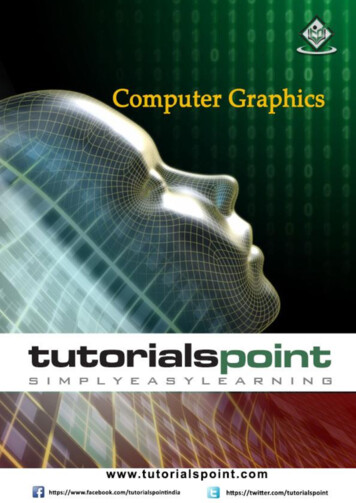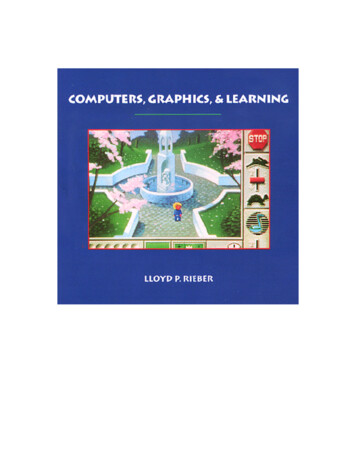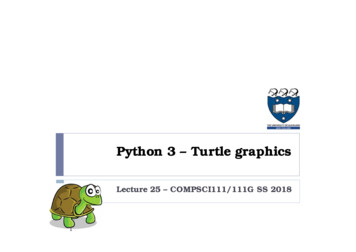
Transcription
r
Computer GraphicsAbout the TutorialTo display a picture of any size on a computer screen is a difficult process. Computergraphics are used to simplify this process. Various algorithms and techniques are used togenerate graphics in computers. This tutorial will help you understand how all these areprocessed by the computer to give a rich visual experience to the user.AudienceThis tutorial has been prepared for students who don’t know how graphics are used incomputers. It explains the basics of graphics and how they are implemented in computersto generate various visuals.PrerequisitesBefore you start proceeding with this tutorial, we assume that you are already aware ofthe basic concepts of C programming language and basic mathematics.Copyright & Disclaimer Copyright 2016 by Tutorials Point (I) Pvt. Ltd.All the content and graphics published in this e-book are the property of Tutorials Point (I)Pvt. Ltd. The user of this e-book is prohibited to reuse, retain, copy, distribute or republishany contents or a part of contents of this e-book in any manner without written consentof the publisher.We strive to update the contents of our website and tutorials as timely and as precisely aspossible, however, the contents may contain inaccuracies or errors. Tutorials Point (I) Pvt.Ltd. provides no guarantee regarding the accuracy, timeliness or completeness of ourwebsite or its contents including this tutorial. If you discover any errors on our website orin this tutorial, please notify us at contact@tutorialspoint.comi
Computer GraphicsTable of ContentsAbout the Tutorial . iAudience . iPrerequisites . iCopyright & Disclaimer. iTable of Contents . ii1. COMPUTER GRAPHICS – BASICS . 1Cathode Ray Tube . 1Raster Scan . 2Application of Computer Graphics . 32. COMPUTER GRAPHICS – LINE GENERATION ALGORITHM . 4DDA Algorithm . 4Bresenham’s Line Generation . 5Mid-Point Algorithm . 73. COMPUTER GRAPHICS – CIRCLE GENERATION ALGORITHM . 9Bresenham’s Algorithm . 9Mid Point Algorithm . 114. COMPUTER GRAPHICS – POLYGON FILLING . 13Scan Line Algorithm . 13Flood Fill Algorithm . 14Boundary Fill Algorithm . 144-Connected Polygon . 158-Connected Polygon . 16Inside-outside Test . 17ii
Computer Graphics5. COMPUTER GRAPHICS – VIEWING AND CLIPPING . 20Point Clipping . 20Line Clipping . 20Cohen-Sutherland Line Clippings . 20Cyrus-Beck Line Clipping Algorithm . 23Polygon Clipping (Sutherland Hodgman Algorithm) . 24Text Clipping . 25Bitmap Graphics . 276. COMPUTER GRAPHICS – 2D TRANSFORMATION . 29Homogenous Coordinates . 29Translation . 29Rotation . 30Scaling . 32Reflection . 33Shear . 34Composite Transformation. 357. COMPUTER GRAPHICS – 3D GRAPHICS . 37Parallel Projection . 37Orthographic Projection . 38Oblique Projection . 39Isometric Projections . 39Perspective Projection . 40Translation . 41Rotation . 42Scaling . 43iii
Computer GraphicsShear . 44Transformation Matrices. 458. COMPUTER GRAPHICS – CURVES . 46Types of Curves . 46Bezier Curves. 46Properties of Bezier Curves . 47B-Spline Curves . 48Properties of B-spline Curve . 499.COMPUTER GRAPHICS – SURFACES . 50Polygon Surfaces . 50Polygon Tables . 50Plane Equations . 51Polygon Meshes . 5210. COMPUTER GRAPHICS – VISIBLE SURFACE DETECTION . 54Depth Buffer (Z-Buffer) Method . 54Scan-Line Method . 55Area-Subdivision Method . 56Back-Face Detection . 57A-Buffer Method . 58Depth Sorting Method . 60Binary Space Partition (BSP) Trees . 6111. COMPUTER GRAPHICS – FRACTALS . 62What are Fractals? . 62Generation of Fractals . 62Geometric Fractals . 63iv
Computer Graphics12. COMPUTER GRAPHICS – COMPUTER ANIMATION . 65Animation Techniques . 65Key Framing . 66Morphing . 67v
1. Computer Graphics – BasicsComputer GraphicsComputer graphics is an art of drawing pictures on computer screens with the help ofprogramming. It involves computations, creation, and manipulation of data. In other words,we can say that computer graphics is a rendering tool for the generation and manipulation ofimages.Cathode Ray TubeThe primary output device in a graphical system is the video monitor. The main element of avideo monitor is the Cathode Ray Tube (CRT), shown in the following illustration.The operation of CRT is very simple:1. The electron gun emits a beam of electrons (cathode rays).2. The electron beam passes through focusing and deflection systems that direct ittowards specified positions on the phosphor-coated screen.3. When the beam hits the screen, the phosphor emits a small spot of light at eachposition contacted by the electron beam.4. It redraws the picture by directing the electron beam back over the same screen pointsquickly.Figure: Cathode Ray Tube6
Computer GraphicsThere are two ways (Random scan and Raster scan) by which we can display an object on thescreen.Raster ScanIn a raster scan system, the electron beam is swept across the screen, one row at a timefrom top to bottom. As the electron beam moves across each row, the beam intensity isturned on and off to create a pattern of illuminated spots.Picture definition is stored in memory area called the Refresh Buffer or Frame Buffer. Thismemory area holds the set of intensity values for all the screen points. Stored intensity valuesare then retrieved from the refresh buffer and “painted” on the screen one row (scan line) ata time as shown in the following illustration.Each screen point is referred to as a pixel (picture element) or pel. At the end of each scanline, the electron beam returns to the left side of the screen to begin displaying the next scanline.Figure: Raster ScanRandom Scan (Vector Scan)In this technique, the electron beam is directed only to the part of the screen where thepicture is to be drawn rather than scanning from left to right and top to bottom as in rasterscan. It is also called vector display, stroke-writing display, or calligraphic display.7
Computer GraphicsPicture definition is stored as a set of line-drawing commands in an area of memory referredto as the refresh display file. To display a specified picture, the system cycles through theset of commands in the display file, drawing each component line in turn. After all the linedrawing commands are processed, the system cycles back to the first line command in thelist.Random-scan displays are designed to draw all the component lines of a picture 30 to 60times each second.Figure: Random ScanApplication of Computer GraphicsComputer Graphics has numerous applications, some of which are listed below: Computer graphics user interfaces (GUIs) – A graphic, mouse-oriented paradigmwhich allows the user to interact with a computer. Business presentation graphics - "A picture is worth a thousand words". Cartography - Drawing maps. Weather Maps – Real-time mapping, symbolic representations. Satellite Imaging - Geodesic images. Photo Enhancement - Sharpening blurred photos. Medical imaging - MRIs, CAT scans, etc. - Non-invasive internal examination.8
Computer Graphics Engineering drawings - mechanical, electrical, civil, etc. - Replacing the blueprintsof the past. Typography - The use of character images in publishing - replacing the hard type ofthe past. Architecture - Construction plans, exterior sketches - replacing the blueprints andhand drawings of the past. Art - Computers provide a new medium for artists. Training - Flight simulators, computer aided instruction, etc. Entertainment - Movies and games. Simulation and modeling - Replacing physical modeling and enactments9
2. Computer Graphics – Line Generation AlgorithmComputer GraphicsA line connects two points. It is a basic element in graphics. To draw a line, you need twopoints between which you can draw a line. In the following three algorithms, we refer the onepoint of line as X0, Y0 and the second point of line as X1, Y1.DDA AlgorithmDigital Differential Analyzer (DDA) algorithm is the simple line generation algorithm which isexplained step by step here.Step 1: Get the input of two end points (X0, Y0) and (X1, Y1).Step 2: Calculate the difference between two end points.dx X1 - X0dy Y1 - Y0Step 3: Based on the calculated difference in step-2, you need to identify the number of stepsto put pixel. If dx dy, then you need more steps in x coordinate; otherwise in y coordinate.if(absolute(dx) absolute(dy))Steps absolute(dx);elseSteps absolute(dy);Step 4: Calculate the increment in x coordinate and y coordinate.Xincrement dx / (float) steps;Yincrement dy / (float) steps;Step 5: Put the pixel by successfully incrementing x and y coordinates accordingly andcomplete the drawing of the line.for(int v 0; v Steps; v ){x x Xincrement;10
Computer Graphicsy y Yincrement;putpixel(Round(x), Round(y));}Bresenham’s Line GenerationThe Bresenham algorithm is another incremental scan conversion algorithm. The bigadvantage of this algorithm is that, it uses only integer calculations. Moving across the x axisin unit intervals and at each step choose between two different y coordinates.For example, as shown in the following illustration, from position (2, 3) you need to choosebetween (3, 3) and (3, 4). You would like the point that is closer to the original line.At sample position xk 1, the vertical separations from the mathematical line are labelled asdupper and dlower.11
Computer GraphicsFrom the above illustration, the y coordinate on the mathematical line at xk 1 is:𝑌 𝑚(𝑋𝑘 1) 𝑏So,dupper and dlower are given as follows:𝑑𝑙𝑜𝑤𝑒𝑟 𝑦 𝑦𝑘 𝑚(𝑋𝑘 1) 𝑏 𝑌𝑘and𝑑𝑢𝑝𝑝𝑒𝑟 (𝑦𝑘 1) 𝑦 𝑌𝑘 1 𝑚(𝑋𝑘 1) 𝑏You can use these to make a simple decision about which pixel is closer to the mathematicalline. This simple decision is based on the difference between the two pixel positions.𝑑𝑙𝑜𝑤𝑒𝑟 𝑑𝑢𝑝𝑝𝑒𝑟 2𝑚(𝑥𝑘 1) 2𝑦𝑘 2𝑏 1Let us substitute m with dy/dx where dx and dy are the differences between the end-points.𝑑𝑥(𝑑𝑙𝑜𝑤𝑒𝑟 𝑑𝑢𝑝𝑝𝑒𝑟 ) 𝑑𝑥(2𝑑𝑦𝑑𝑥(𝑥𝑘 1) 2𝑦𝑘 2𝑏 1) 2𝑑𝑦 𝑥𝑘 2𝑑𝑥 𝑦𝑘 2𝑑𝑦 𝑑𝑥(2𝑏 1) 2𝑑𝑦 𝑥𝑘 2𝑑𝑥 𝑦𝑘 𝐶So, a decision parameterpk for the kth step along a line is given by:𝑝𝑘 𝑑𝑥(𝑑𝑙𝑜𝑤𝑒𝑟 𝑑𝑢𝑝𝑝𝑒𝑟 )12
Computer Graphics 2𝑑𝑦 𝑥𝑘 2𝑑𝑥 𝑦𝑘 𝐶The sign of the decision parameterIfpk is the same as that of dlower – dupper.pk is negative, then choose the lower pixel, otherwise choose the upper pixel.Remember, the coordinate changes occur along the x axis in unit steps, so you can doeverything with integer calculations. At step k 1, the decision parameter is given as:𝑝𝑘 1 2𝑑𝑦 𝑥𝑘 1 2𝑑𝑥 𝑦𝑘 1 𝐶Subtractingpk from this we get:𝑝𝑘 1 𝑝𝑘 2𝑑𝑦(𝑥𝑘 1 𝑥𝑘 ) 2𝑑𝑥(𝑦𝑘 1 𝑦𝑘 )But,xk 1 is the same as xk 1. So:𝑝𝑘 1 𝑝𝑘 2𝑑𝑦 2𝑑𝑥(𝑦𝑘 1 𝑦𝑘 )Where,yk 1 – yk is either 0 or 1 depending on the sign of pk.The first decision parameter p0 is evaluated at (x0, y0) is given as:𝑝0 2𝑑𝑦 𝑑𝑥Now, keeping in mind all the above points and calculations, here is the Bresenham algorithmfor slope m 1:Step 1: Input the two end-points of line, storing the left end-point in (x0, y0).Step 2: Plot the point (x0, y0).Step 3: Calculate the constants dx, dy, 2dy, and (2dy – 2dx) and get the first value for thedecision parameter as:𝑝0 2𝑑𝑦 𝑑𝑥Step 4: At eachxk along the line, starting at k 0, perform the following test:If pk 0, the next point to plot is (xk 1, yk) and𝑝𝑘 1 𝑝𝑘 2𝑑𝑦Otherwise, the next point to plot is (xk 1, yk 1) and𝑝𝑘 1 𝑝𝑘 2𝑑𝑦 2𝑑𝑥Step 5: Repeat step 4 (dx – 1) times.13
Computer GraphicsFor m 1, find out whether you need to increment x while incrementing y each time. Aftersolving, the equation for decision parameterequation gets interchanged.pk will be very similar, just the x and y in theMid-Point AlgorithmMid-point algorithm is due to Bresenham which was modified by Pitteway and Van Aken.Assume that you have already put the point P at (x, y) coordinate and the slope of the line is0 k 1 as shown in the following illustration.Now you need to decide whether to put the next point at E or N. This can be chosen byidentifying the intersection point Q closest to the point N or E. If the intersection point Q isclosest to the point N then N is considered as the next point; otherwise E.Figure: Mid-point AlgorithmTo determine that, first calculate the mid-point M(x 1, y ½). If the intersection point Q ofthe line with the vertical line connecting E and N is below M, then take E as the next point;otherwise take N as the next point.In order to check this, we need to consider the implicit equation:F(x,y) mx b - yFor positive m at any given X, If y is on the line, then F(x, y) 0 If y is above the line, then F(x, y) 0 If y is below the line, then F(x, y) 014
Computer Graphics15
3. Computer Graphics – Circle Generation AlgorithmComputer GraphicsDrawing a circle on the screen is a little complex than drawing a line. There are two popularalgorithms for generating a circle: Bresenham’s Algorithm and Midpoint CircleAlgorithm. These algorithms are based on the idea of determining the subsequent pointsrequired to draw the circle. Let us discuss the algorithms in detail:The equation of circle is X2 Y2 r2, where r is b,-a)Bresenham’s AlgorithmWe cannot display a continuous arc on the raster display. Instead, we have to choose thenearest pixel position to complete the arc.From the following illustration, you can see that we have put the pixel at (X, Y) location andnow need to decide where to put the next pixel: at N (X 1, Y) or at S (X 1, Y-1).16
Computer GraphicsThis can be decided by the decision parameter d. If d 0, then N(X 1, Y) is to be chosen as next pixel. If d 0, then S(X 1, Y-1) is to be chosen as the next pixel.AlgorithmStep 1: Get the coordinates of the center of the circle and radius, and store them in x, y, andR respectively. Set P 0 and Q R.Step 2: Set decision parameter D 3 – 2R.Step 3: Repeat through step-8 while X Y.Step 4: Call Draw Circle (X, Y, P, Q).Step 5: Increment the value of P.Step 6: If D 0 then D D 4x 6.Step 7: Else Set Y Y 1, D D 4(X-Y) 10.Step 8: Call Draw Circle (X, Y, P, Q).Draw Circle Method(X, Y, P, Q).Call Putpixel (X P, Y Q).Call Putpixel (X - P, Y Q).Call Putpixel (X P, Y - Q).Call Putpixel (X - P, Y - Q).17
Computer GraphicsCall Putpixel (X Q, Y X).Call Putpixel (X - Q, Y X).Call Putpixel (X Q, Y - X).Call Putpixel (X - Q, Y - X).Mid Point AlgorithmStep 1: Input radius r and circle center (xc, yc) and obtain the first point on the circumferenceof the circle centered on the origin as(x0, y0) (0, r)Step 2: Calculate the initial value of decision parameter asP0 5/4 – r (See the following description for simplification of this equation.)f(x, y) x2 y2 - r2 0f(xi - 1/2 e, yi 1) (xi - 1/2 e)2 (yi 1)2 - r2 (xi- 1/2)2 (yi 1)2 - r2 2(xi - 1/2)e e2 f(xi - 1/2, yi 1) 2(xi - 1/2)e e2 018
Computer GraphicsLet di f(xi - 1/2, yi 1) -2(xi - 1/2)e - e2Thus,If e 0 then di 0 so choose point S (x i - 1, yi 1).di 1 f(xi – 1 - 1/2, yi 1 1) ((xi - 1/2) - 1)2 ((yi 1) 1)2 - r2 di - 2(xi - 1) 2(yi 1) 1 di 2(yi 1 - xi 1) 1If e 0 then di 0 so choose point T (x i, yi 1)di 1 f(xi - 1/2, yi 1 1) di 2yi 1 1The initial value of di isd0 f(r - 1/2, 5/4 - r0 1) (r - 1/2)2 12 - r2{1 - r can be used if r is an integer}19
Computer GraphicsWhen point S (xi - 1, yi 1) is chosen, thendi 1 di 2xi 1 2yi 1 1When point T (xi, yi 1) is chosen thendi 1 di 2yi 1 1Step 3: At each XK position starting at K 0, perform the following test:If PK 0 then next point on circle (0,0) is (X K 1,YK) andPK 1 PK 2XK 1 1ElsePK 1 PK 2XK 1 1 – 2YK 1Where, 2XK 1 2XK 2 and 2YK 1 2YK-2.Step 4: Determine the symmetry points in other seven octants.Step 5: Move each calculate pixel position (X, Y) onto the circular path centered on (XC, YC)and plot the coordinate values.X X XC,Y Y YCStep 6: Repeat step-3 through 5 until X Y.20
Computer GraphicsEnd of ebook previewIf you liked what you saw Buy it from our store @ https://store.tutorialspoint.com21
Computer graphics user interfaces (GUIs) – A graphic, mouse-oriented paradigm which allows the user to interact with a computer. Business presentation graphics - "A picture is worth a thousand words". Cartography - Drawing maps. Weather Maps – Real-time mapping, symbo








![Engineering Graphics Essentials [4th Edition]](/img/13/978-1-58503-610-3-1.jpg)

